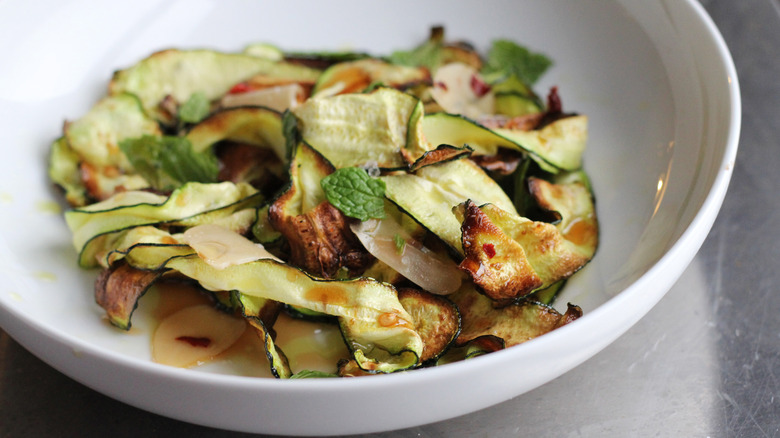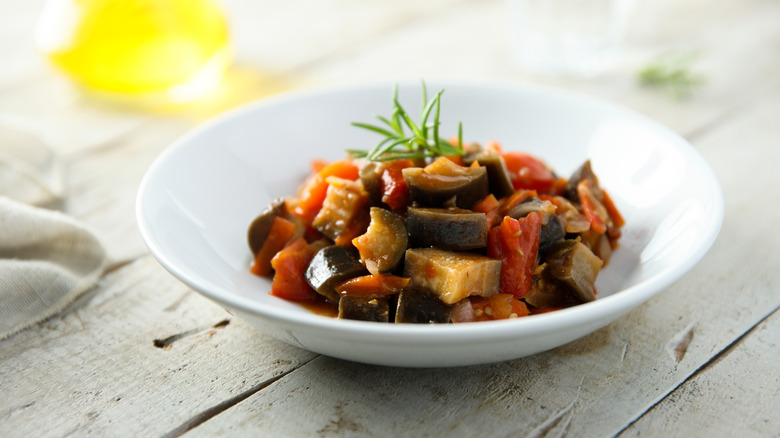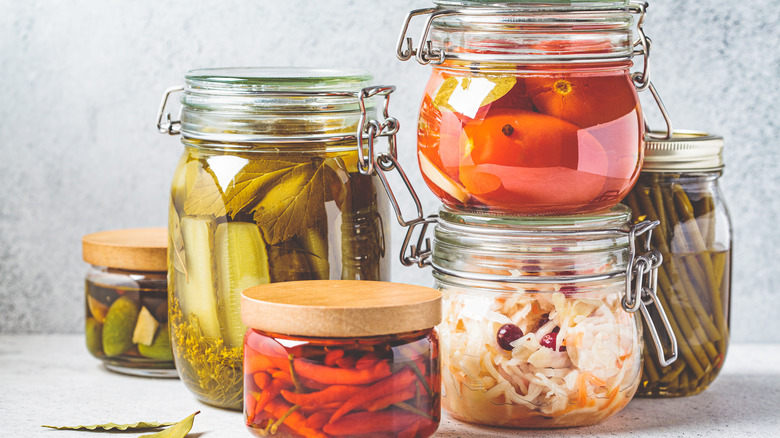What Is Agrodolce And How Do You Make It?
The Italian iteration of a sweet and sour sauce, agrodolce is the distillation of numerous flavors, each hitting the palate simultaneously. Part condiment, part compote, and part sauce, agrodolce can be used in a myriad of ways, acting as anything from the base of a braising liquid to a final drizzle over the top of a dish. If you're familiar, it's a bit similar in flavor to a caponata recipe, an iconic Sicilian dish that also has sweet and tangy flavors.
Blue Apron notes that the name agrodolce translates in Italian to "sour" and "sweet," which gives you a pretty good idea of what tasting notes to expect when you enjoy it with vegetables, meats, and other dishes. At its core, the sauce is a perfect balance of sweetness and acidity, usually achieved with sugar and vinegar but sometimes done with other ingredients. The final consistency should be relatively thick, as the ingredients are cooked until they reduce to a potent syrup. Here's what to know about this versatile Italian specialty.
What does agrodolce taste like?
The bursts of sweetness, acidity, and saltiness delivered by agrodolce are hard to beat — and always a welcome punch of flavor. Various recipes and store-bought versions will have different balances of flavor (strong acid with subtle sweetness, overt sweetness with a background note of acid, etcetera), but the initial note will be one of vinegar. As MasterClass notes, balsamic vinegar makes for a sweeter agrodolce, whereas the red wine vinegar preferred in Sicily results in a more puckery flavor. Cooks' choice of sweetener will also affect the final flavor of agrodolce; white sugar offers a purer sweetness, honey lends a floral quality, and the addition of juice from fruits such as oranges gives agrodolce a brighter finish.
Depending on the recipe — which, as you've gathered, is very adaptable — agrodolce can either be entirely smooth or textured thanks to optional add-ins like chilis, herbs, and citrus zest. Some versions include briny capers or olives, crispy nuts, and sweet dried fruits or alliums that will also alter the taste and texture. Finally, the overall flavor of agrodolce depends on the way you serve it, from a tangy sauce to contrast with a rich steak to a sweet accompaniment for savory roasted vegetables.
How is it made?
Beyond being a delicious condiment, agrodolce can also represent a style or technique of cooking in the "sweet and sour" vein. For example, caponata is essentially a vegetable (typically eggplant-based) relish cooked in an agrodolce manner. As noted by The New York Times, you can also do this with other vegetables, such as zucchini, or as even with braised meats for something like pork agrodolce. These recipes involve mixing up your agrodolce ingredients and cooking them with your choice of protein until highly concentrated.
And how do you mix up an agrodolce? When making the sauce at home, feel free to use whichever vinegars, sweeteners, and extras you have on hand. The main technique, as explained by Bon Appétit, can be as simple as simmering chilis, red wine vinegar, honey, raisins, and red pepper flakes until thickened. After about 10 minutes, the sauce is complete and ready to be enjoyed hot or cool. Other recipes, such as one from MasterClass, may begin with sautéd onion or garlic, continue with the familiar simmering method, and end with the addition of ingredients like nuts, capers, and herbs. Expect a similar technique no matter what kind of agrodolce you make — just be sure to consider the way you want to serve it. Will it be a smooth sauce for vegetables or a chunky, jam-like topping for a cheese board?
How is agrodolce used?
Have a surplus of agrodolce on hand and unsure how to sue it? Whether you make your own or buy it in stores, the Fustini's brand has a bevy of ideas: Use it as spread on a sandwich, a sauce or marinade for cooked meats and seafood, or as a topping for anything from fresh fruit and crostini to a cheese and charcuterie board. On the more unexpected side, some people even incorporate agrodolce into complex cocktails or mocktails!
Agrodolce can be tossed with practically anything, be it pasta to ribs. It can add a caramelized lacquer to grilled or roasted meats, highlight the inherent flavors of charred vegetables, or adhere perfectly to thick noodles. It's even delicious in a dessert context, adding some depth to sweet dishes such as cheesecake. Many chefs use it as a way to make simple side dishes stand out. For New York Times Cooking, chef Gabrielle Hamilton notes the way the Sicilian condiment can transform vegetables, lending a lively fragrance to anything it's added to.
What is agrodolce brine?
Finally, as Food52 explains, there's another type of agrodolce: a pickling method using many of the same ingredients found in the traditional condiment. More of a brine than a sauce, it's incredibly customizable and highly reminiscent of giardinera, or Italian-style pickled vegetables. Naturally, pickling agrodolce can also include sharper flavors, such as black peppercorns and juniper berries. Vegetables that especially benefit from agrodolce brine are zucchini, cauliflower, asparagus, and carrots, while fruits like cherries, pears, plums, and peaches take on a new dimension when prepared this way. You really can't go wrong!
Agrodolce is an endlessly flexible condiment, cooking method, and preservation technique that can be tweaked to the palate of every member of the family. It both spotlights and enhances the innate flavor of various proteins, fruits, starches, and vegetables and, better yet, is simple enough to make at home. If you haven't tried it before, now is the time!




